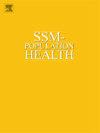地方犯罪与药物使用失调:20 世纪 90 年代和 2000 年代中年人的比较
IF 3.6
2区 医学
Q1 PUBLIC, ENVIRONMENTAL & OCCUPATIONAL HEALTH
引用次数: 0
摘要
本研究调查了 20 世纪 90 年代至 2000 年代期间美国社会政治的变化如何解释药物使用失调症的增加和最近一批美国中年人寿命的缩短。2008 年的经济衰退使全国失业率急剧上升,这可能对包括当地犯罪率和药物使用失调在内的下游环境和个体过程产生了负面影响。美国中年调查队列(1995 年;n = 6148;20-75 岁)和美国中年调查复习队列(2011 年;n = 3543;23-76 岁)报告了药物使用失调的情况。这些数据与《统一犯罪报告》的暴力犯罪率相关联,以确定在 2008 年经济衰退之前或之后接受评估的两组不同的美国中年成人中,当地犯罪与药物使用失调之间的关系是否发生了变化。1995 年,尽管当地犯罪率较高,但药物使用失调与当地犯罪并无关联。然而,2011 年相对较低的犯罪率却与更高的药物使用失调率有关。考虑到十年一次的人口普查和美国社区调查中的失业率,2011 年的失业率比 1995 年高出很多,这完全削弱了当地犯罪率与药物使用失调之间的联系。在本次研究中,我们观察到最近一批接受评估的中年成年人的药物使用障碍患病率有所上升,这可能是2008年经济衰退后对当地犯罪的不适应性应对。本文章由计算机程序翻译,如有差异,请以英文原文为准。
Local crime and substance use disorders: A comparison of midlife adults in the 1990s and 2000s
This study investigated how sociopolitical changes in the United States between the 1990s and 2000s may explain the increase in substance use disorders and reduced longevity in more recent cohorts of US midlife adults. The 2008 recession which drastically increased unemployment rates across the country may have had negative implications for downstream contextual and individual processes, including both local crime rates and substance use disorders. The Midlife in the United States Survey cohort (1995; n = 6148; 20–75 years) and the MIDUS Refresher cohort (2011; n = 3543; 23–76 years) reported on substance use disorders. These data were linked to Uniform Crime Reporting violent crime rates to determine whether associations between local crime and substance use disorders changed among two separate cohorts of US midlife adults assessed before or after the 2008 recession. In 1995, despite higher local crime rates, substance use disorders were not associated with local crime. The comparatively lower crime rates of 2011, however, associated with greater prevalence of substance use disorders. Considering unemployment rates from the Decennial Census and American Community Survey, which were substantially higher in 2011 relative to 1995, completely diminished the local crime rate-substance use disorder association. The increased prevalence of substance use disorders observed in the more recent cohort of midlife adults assessed in the current study may represent maladaptive coping to local crime after the 2008 recession.
求助全文
通过发布文献求助,成功后即可免费获取论文全文。
去求助
来源期刊

Ssm-Population Health
PUBLIC, ENVIRONMENTAL & OCCUPATIONAL HEALTH-
CiteScore
6.50
自引率
2.10%
发文量
298
审稿时长
101 days
期刊介绍:
SSM - Population Health. The new online only, open access, peer reviewed journal in all areas relating Social Science research to population health. SSM - Population Health shares the same Editors-in Chief and general approach to manuscripts as its sister journal, Social Science & Medicine. The journal takes a broad approach to the field especially welcoming interdisciplinary papers from across the Social Sciences and allied areas. SSM - Population Health offers an alternative outlet for work which might not be considered, or is classed as ''out of scope'' elsewhere, and prioritizes fast peer review and publication to the benefit of authors and readers. The journal welcomes all types of paper from traditional primary research articles, replication studies, short communications, methodological studies, instrument validation, opinion pieces, literature reviews, etc. SSM - Population Health also offers the opportunity to publish special issues or sections to reflect current interest and research in topical or developing areas. The journal fully supports authors wanting to present their research in an innovative fashion though the use of multimedia formats.
 求助内容:
求助内容: 应助结果提醒方式:
应助结果提醒方式:


